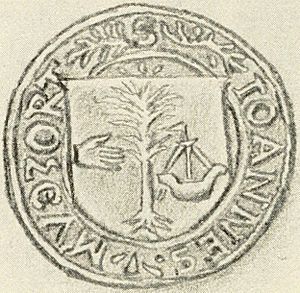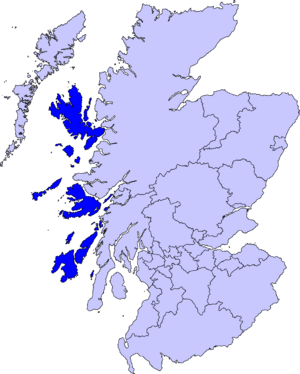Birlinn facts for kids
The birlinn (pronounced "bir-linn") was a type of wooden ship used a long time ago in the Hebrides and West Highlands of Scotland. These ships were powered by both sails and oars. People also called them "West Highland galleys."
The word "birlinn" might come from an old Norse word, byrðingr, which meant a cargo ship. Most experts believe the birlinn's design was influenced by Viking ships.
Birlinns were built using a method called clinker-built, where wooden planks overlap each other. They had one mast with a square sail. Smaller birlinns might have had as few as twelve oars, while larger ones, like the West Highland galley, could have as many as forty oars! For over 400 years, until the 1600s, the birlinn was the most important ship in the Hebrides.
In 1310, King Robert the Bruce even asked for birlinns as a payment from one of his lords. A report from 1615 said that galleys had 18 to 20 oars, and birlinns had 12 to 18 oars. They were very similar.
You can sometimes see a birlinn in Scottish heraldry (family crests and symbols). It's called a "lymphad" there, which comes from the Scottish Gaelic words long fhada meaning "long ship."
Contents
What Were Birlinns Used For?
Birlinns were very important in the islands because ships were essential for travel and even for fighting. Local lords used birlinns a lot, especially for battles at sea. The MacDonalds of Islay were known for having a very strong navy of these ships.
The Lords of the Isles, powerful rulers in the Middle Ages, had the biggest fleet of birlinns. These ships might have been used in a famous sea battle in 1156, where Somerled, an important lord, fought his brother-in-law to become the ruler of the Hebrides.
In 1608, King James VI of Scotland sent someone to stop fights in the Western Isles. His orders included destroying the ships, like lymphads, galleys, and birlinns, that belonged to rebellious people.
Even though we mostly hear about birlinns being used for war, they were also used for trade. There's evidence of trading centers in places like Islay and Kintyre. In the 1300s, there was a lot of trade between the Isles, Ireland, and England, supported by the local lords. It's possible that birlinns were used for both fighting and trading. They also carried troops, helped with fishing, and even transported cattle!
How Were Birlinns Built?
Birlinns were built in a way that was similar to the strong, ocean-going ships of the Norse (Viking) people. They were built with a strong keel (the backbone of the ship) and thin planks of wood that overlapped. These planks were joined together with iron nails.
The shape of the birlinn's hull (the main body of the ship) looked a lot like Norse ships. Old pictures show that birlinns had a rudder for steering. Builders likely used dried moss soaked in tar to seal the gaps between the planks, making the boat waterproof.
Oak wood was the favorite choice for building birlinns because it was tough and didn't rot easily. While the Outer Isles of Scotland didn't have much timber, the Inner Isles and the mainland had plenty of oak, birch, and pine trees. There was so much wood in a place called Lochaber that people had a saying: "Bringing wood to Lochaber" meant doing something totally unnecessary!
The tools used to build birlinns were probably similar to those used by carpenters in Northern Europe. These included adzes (a tool like an axe), axes, augers (for drilling holes), and planes (for smoothing wood). Builders often relied on their eye for measurements rather than strict rulers.
After building, boats were often kept safe in special dug-out areas on the bank called "nausts." There's also evidence of built harbors and boat landings at fortified sites.
We don't have any large pieces of a birlinn left today, so we can't be completely sure about all the building details. However, old boat-building traditions and words can give us clues.
Sails and Ropes
Old carvings of birlinns from the 1500s and earlier show how they were rigged. They had ropes called braces, a forestay (from the mast to the front), a backstay (from the mast to the back), and shrouds (ropes supporting the mast from the sides). They also had a halyard (to raise the sail) and a parrel (to hold the sail yard to the mast). The rudder had special hinges called pintles and gudgeons.
Traditionally, sails in the Highlands were made from strong, thick wool. Ropes were made from moss-fir or heather. Medieval sails were often sewn together from many small squares of fabric.
Aileach: A Rebuilt Birlinn

in Loch Etive
In 1991, a 16-oar Highland galley called the Aileach was built in County Donegal, Ireland. It was based on pictures of birlinns found in old Scottish carvings. Even though the Aileach sailed well, its design might not be perfectly accurate because the carvings it was based on were small and cramped.
The Aileach had a very tall, almost straight, front and back. It was hard to fit more than one rower per oar, and the rowing seats were too close together. Other, clearer pictures from the 1300s and 1400s show birlinns that were longer and bigger.
Birlinns in Ireland
Similar ships, called long fhada in Ireland, were also used there. They looked a lot like the West Highland birlinns, but we haven't found any old parts of them yet.
Old Irish records mention fleets of ships being used in Ireland, often with a connection to Scotland. For example, in 1413, a man named Tuathal Ó Máille was sailing with seven ships when a big storm hit, pushing them all the way to Scotland. Only one ship survived! In 1433, a powerful Scottish lord, Macdonald of the Isles, arrived in Ireland with a large fleet to help in a war.
In Ireland, families like the O'Malleys and O'Flathertys used oared ships a lot for fighting and even for piracy. English officials had to use similar ships to fight against them. One very famous Irish ruler was Grace O'Malley, who in 1591 was said to have twenty ships! She used her ships for a lot of trade, just like her father.
There was always a lot of ship traffic between Ireland and Scotland. Scottish soldiers, called mercenaries, were often carried to Ireland on birlinns.
How Birlinns Fought
When rowed, the birlinn was very fast and could often escape from ships trying to catch it. Even in later times, birlinns didn't have cannons. They were built too lightly, and their sides weren't high enough to hold heavy guns.
However, birlinns were great for quick raids. With skilled archers or fighters on board, they could defend themselves well against smaller boats. These ships were most in danger when they were pulled onto the beach or when a heavier ship with cannons cornered them.
Did Birlinn Designs Change?

Some evidence suggests that birlinn designs might have started to change by the late 1500s. A carving from 1641 shows a ship with a lower front and back. An English map from around 1603 shows Scottish Highlander ships with one mast and a square sail, but also a small cabin at the back.
Two old seals from 1572, belonging to a clan called Clanranald, show a birlinn with raised decks at the front and back. If these changes happened, they might have been influenced by ship designs from the south-east, possibly even from the Mediterranean Sea. However, some people think the evidence for these changes is not very strong. Still, there are pictures that show similar changes in Irish galleys.
See Also
- Irish galley


